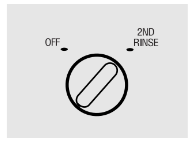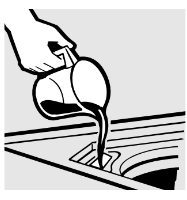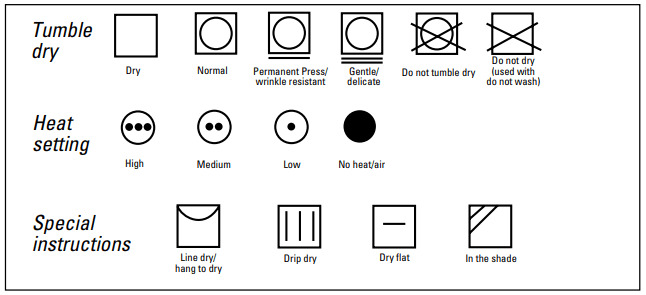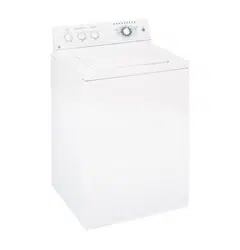Documents: Go to download!
- Owner's manual - (English)
- CONTROL PANEL
- WASHER FEATURES
- USING THE WASHER
- Care and Cleaning
- Fabric Care Labels
- TROUBLESHOOTING
- Washer Operation
Table of contents
Washers Owner’s Manual
CONTROL PANEL

1 Load Size
The water level should just cover the clothes. Adjust the load size accordingly. Loosely load clothes no higher than the top row of holes in the washer tub.
2 Custom Care Wash/Spin Speeds (on some models)
The agitator moves clothes around for a cleaner wash; the basket spins later in the cycle to release water from the load. The Wash/Spin Speed dial sets the speed of both the agitator and the basket.
- With Normal wash speed, the agitator will move at a high speed for the first few minutes. It will then step down to a moderate speed. This will help to maximize soil removal while reducing the wear on your clothing. Use for cottons, denims and play clothes.
- With Gentle wash speed, the agitator moves slower. Use for delicate and knit items.
- The Fast spin speed is for durable items.
- The Slow spin speed is for delicate items like sweaters and lingerie. When using Slow spin speed, clothes will be less dry than when using Fast spin speed.
3 Temperature
Select the water temperature for the wash and rinse cycles. Always follow fabric manufacturer’s care label or instructions when laundering. Follow the water temperature guide on the washer lid.
4 Wash Cycle
The wash cycle controls the length of the washing process. When choosing the cycle, the Cycle Selector knob can be pointed anywhere within the colored box. The knob can be turned in either direction. Turning the Cycle Selector knob after starting a cycle will stop the washer and reset the cycle to the new selection. Press START to begin the new cycle selection.

The Cycle Indicator Lights show what stage the washer is in. The wash time is the length of the wash agitation. The 6 MIN light will remain lit during drain and spin. When the Selector knob is set to a new cycle the Indicator Lights will flash momentarily, showing what stages the cycle will go through.
Below will help you match the wash cycle setting with your clothing.
- COTTONS For heavy to lightly soiled cottons, household linens, work and play clothes.
- EASY CARE For wrinkle-free and permanent press items, and knits.
- DELICATES For lingerie and special-care fabrics with light soils. Provides periods of agitation and soak during wash and rinse.
- EXTRA HEAVY For heavily soiled and heavy-duty fabrics. This cycle provides a longer agitation.
- MIN/30 MIN For heavily soiled clothes. Begins with a brief agitation, soaks for a specified period of time, then moves
- AUTO SOAK through the rest of the cycle automatically.
5 START
Press START to begin the cycle. Pressing START again or raising the lid will PAUSE the cycle and the Cycle indicator light will blink.
WASHER FEATURES
2nd Rinse Option (on some models)
| When you use extra detergent or bleach to clean heavily soiled clothes, you may want to use the 2nd Rinse option. It provides a second deep cold rinse. |  |
Liquid Bleach Dispenser
The dispenser dilutes liquid chlorine bleach before it reaches into your wash load.
Do not mix chlorine bleach with ammonia or acids such as vinegar and/or rust remover. Mixing can produce a toxic gas which may cause death. |  |
The Agitator Cap or Fabric Softener Dispenser
The agitator cap fits into the top of the agitator. If it accidentally comes off, simply put it back on.
The Fabric Softener Dispenser
 | The fabric softener dispenser automatically releases liquid fabric softener at the proper time during the cycle. Do NOT stop the washer during the first spin. This will cause the dispenser to empty too soon. To use, follow these steps: 1. Make sure dispenser is securely attached to aligator. 2. Use only diluted liquid fabric softener. Pour into dispenser, using amount recommended on package. Never pour fabric softener directly on clothes. It may stain them. *NOTE: Do not pour bleach into FABRIC SOFTENER dispenser. |
Do NOT pour anything into the agitator if the dispenser is removed. | 3. Add water to dispenser until it reaches the maximum fill line. |
Cleaning the Fabric Softener Dispenser
1. Remove the dispenser from the top of the agitator. 2. Separate the dispenser cup from the cover by grasping the top and pushing down on the inside of Dispenser cup will pop free from the cover. 3. To clean the dispenser, soak both the dispenser cup and the dispenser cover in the following solution: 1 US gallon (3.8 liters) warm water 1/4 cup (60 ml) heavy-duty liquid detergent 1 cup (240 ml) bleach
5. Rinse and reassemble dispenser. Place dispenser back on the agitator. |  |
USING THE WASHER
Sorting Wash Loads

Proper Use of Detergent
- Add detergent and start the washer before adding clothes so that the detergent can work effectively.
- Using too little or too much detergent is a common cause of laundry problems.
- You can use less detergent if you have soft water, a smaller load, or a lightly soiled load.
Loading the Washer
- Load dry items loosely, no higher than the top row of holes in the washer tub.
- When loading wet items make sure you set the load/water level high enough to allow the items to move freely. Water level should just cover the clothes.
- To add items after washer has started, lift the lid and submerge additional items next to the agitator.
- Do not wrap large items like sheets around the agitator.
- Do not wash fabrics containing flammable materials (waxes, cleaning fluids, etc.).
- Agitation will not start with the lid up.
Care and Cleaning
- Wash Basket: Leave the lid open after washing to allow moisture to evaporate. If you want to clean the basket, use a clean soft cloth dampened with liquid detergent; then rinse. (Do not use harsh or gritty cleaners.)
- Fill Hoses: GE recommends changing the hoses every years.
- Exterior: Immediately wipe off any spills. Wipe with damp cloth. Try not to hit surface with sharp objects.
- Moving and Storage: Ask the service technician to remove water from drain pump and hoses. See the Installation Instructions packed with product for information on how to reinstall the shipping rod to keep the tub stationary when moving the washer
- Long Vacations: Be sure water supply is shut off at faucets. Drain all water from hoses if weather will be below freezing.
Fabric Care Labels
WASH LABELS

DRY LABELS

BLEACH LABELS

TROUBLESHOOTING
Water
Too many suds
Too much detergent
>>> Measure your detergent carefully. Use less soap if you have soft water, a smaller load or a lightly soiled load.
Very soft water
>>> Try less detergent.
Type of detergent
>>> Switch to a lower sudsing detergent brand and follow instructions on package.
Water leaks
Using too much detergent
>>> Use less detergent. Use less soap if you have soft water, a smaller load or a lightly soiled load.
Fill hoses or drain hose is improperly connected
>>> Make sure hose connections are tight at faucets and rubber washers are installed. Make sure end of drain hose is correctly inserted in and secured to drain facility.
Household drain may be clogged.
>>> Check household plumbing. You may need to call a plumber.
Tighten hoses at the faucets and turn the water off after each use.
>>> Constant water pressure to the fill hoses at the water source
>>> Check condition of the fill hoses; they should be replaced every 5 years.
Water temperature seems incorrect
Cooler water temperatures provide improved energy efficiency
New laundry detergents have been formulated to work with cooler water temperatures without affecting wash performance.
Water supply is turned off or improperly connected
>>> Turn both hot and cold faucets fully on and make sure hoses are connected to correct faucets.
Water valve screens are stopped up
>>> Turn off the water source and remove the water connection hoses from the upper back of the washer. Use a brush or toothpick to clean the screens in the machine. Reconnect the hoses and turn the water back on.
House water heater is not set properly
>>> Make sure house water heater is delivering water at 120°F–140°F (48°C–60°C)
Control is not set properly
>>> Check water temperature control and adjust.
Water pumped out before cycle is complete
Lid lifted or cycle was put in pause for over hours
>>> Reset cycle
Water won’t drain
Drain hose is kinked or improperly connected
Washer OperationStraighten drain hose and make sure washer is not sitting on it. Top of drain outlet should be less than 8 ft (2.5 m) above floor.
Washer Operation
Washer pauses in cycle
The DELICATES cycle was chosen
>>> This is normal. The washer may pause during the spin cycle to remove soapy water more efficiently.
Wash speed changes
Wash speed changes
>>> It is normal for the Normal wash speed to change from fast to moderate during the wash cycle.
Washer won’t operate
Washer is unplugged
>>> Make sure cord is plugged securely into a working outlet.
Water supply is turned off
>>> Turn both hot and cold faucets fully on.
Controls are not set properly
>>> Check controls.
Lid is open
>>> Close lid
Circuit breaker/fuse is tripped/blown
>>> Check house circuit breakers/fuses. Replace fuses or reset breaker. Washer should have separate outlet.
Electronics need to be reset
>>> Unplug washer, wait 2 minutes, plug back in and press Start.
Start was not pressed
>>> Press Start.
Washer Performance
Clothes too wet
Incorrect spin cycle selected
>>> Make sure the spin cycle selected matches the load you are washing. Some fabrics will feel wetter when rinsed with cold water.
Colored spots
Incorrect use of fabric softener
>>> Check fabric softener package for instructions and follow directions for using dispenser.
>>> Pretreat stain and rewash.
Dye transfer
>>> Sort whites or lightly colored items from dark colors
Grayed or yellowed clothes
Not enough detergent
>>> Use more detergent (especially with larger loads). Be sure to follow detergent manufacturer’s directions.
Hard water
>>> Use a water conditioner like Calgon brand or install a water softener.
Water is not hot enough
>>> Make sure water heater is delivering water at 120°F–140°F (48°C–60°C).
Washer is overloaded
>>> Select load size to match clothes load.
Detergent is not dissolving
>>> Add detergent as wash basket fills with water before you load clothes.
Dye transfer
>>> Sort clothes by color. If fabric label states wash separately, unstable dyes may be indicated.
Lint or residue on clothes
Clothes are air or line dried
>>> If you do not dry your clothes with a clothes dryer, your clothes may retain more lint.
Incorrect sorting
>>> Separate lint producers from lint collectors.
Washing too long
>>> Wash small loads for a shorter time than larger loads
Detergent not dissolving
>>> Add detergent as wash basket fills with water, before you load clothes.
>>> Try a liquid detergent.
>>> Use warmer water temperature.
Overloading
>>> Load clothes no higher than the top row of holes in the washer basket.
>>> Make sure load size selector matches clothes load size.
Incorrect use of fabric softener
>>> Check fabric softener package for instructions and follow directions for using dispenser.
Pilling
Result of normal wear on poly-cotton blends and fuzzy fabrics
>>> While this is not caused by the washer, you can slow the pilling process by washing garments inside out.
Snags, holes, tears, rips or excessive wear
Pins, snaps, hooks, sharp buttons, belt buckles, zippers and sharp objects left in pockets
>>> Fasten snaps, hooks, buttons and zippers.
>>> Remove loose items like pins, objects in pockets and sharp buttons.
>>> Turn knits (which snag easily) inside out.
Undiluted chlorine bleach
>>> Check bleach package instructions for proper amount.
>>> Never add undiluted bleach to wash or allow clothes to come in contact with undiluted bleach.
Chemicals like hair bleach or dye, permanent wave solution
>>> Rinse items that may have chemicals on them before washing.
Wrinkling
Improper sorting
>>> Avoid mixing heavy items (like work clothes) with light items (like blouses).
>>> Try a fabric softener.
Overloading or incorrect water level
>>> Load your washer so clothes have enough room to move freely.
Incorrect wash and dry cycles
>>> Match Cycle selection to the type of fabric you are washing especially for easy care loads).
Repeated washing in water that is too hot
>>> Wash in warm or cold water.
NOISE
Washer is noisy
Washer is uneven
>>> To level the front of the washer, adjust the front leveling legs by rotating the individual leg in the proper direction for up or down. To level back of washer, lift back of machine 4′′ (11 cm) and set down.
Washer load is unbalanced
>>> Press PAUSE to stop the washer, open the lid and unbalanced redistribute the load evenly. Close the lid and press START.
Shipping rod is still assembled
>>> To remove shipping rod from washer, pull yellow tag and in unit attached rod from the bottom right hand side of washer.
Washer is sitting too close
>>> Pull washer away from the wall; about 4′′ (11 cm) to wall (causes knocking is needed. during cycle)
OTHER
Labels on the exterior will not peel off cleanly
Occasionally the adhesive
>>> Use a hair dryer set at the lowest heat setting, directing of the washer will not used on the labels does the air at the label for a short amount of time. This will peel off cleanly not release cleanly release the adhesive easily, without damaging the surface of the washer.
See other models: JGB697DEH1WW PDW9800J10BB HTS18BCPMRWW GLD4408R10BB ETS19XBMBRCC

